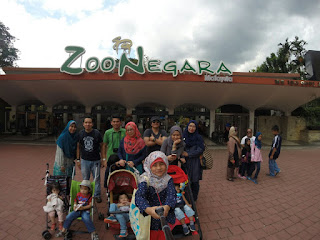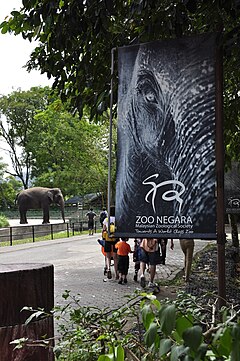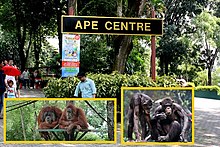 |
| The 6 Cucus..... |
iNFO - National Zoo of Malaysia
From Wikipedia, the free encyclopedia
Elephant in Negara Zoo 2011
| |
| Date opened | 14 November 1963[1] |
|---|---|
| Location | Ulu Klang, Selangor, Malaysia |
| Coordinates | 3°12′35″N 101°45′28″ECoordinates: 3°12′35″N 101°45′28″E |
| Land area | 110 acres (45 ha)[2] |
| Number of animals | 5137[2] |
| Number of species | 459[2] |
| Annual visitors | >1,000,000 |
| Memberships | ISO 9001:2008,[3] SEAZA[4] |
| Major exhibits | 16 major exhibits |
| Website | www |
The National Zoo (Malay: Zoo Negara) is a zoo in Malaysia located on 110 acres (45 ha) of land in Ulu Klang, near Taman Melawati, in north-east Kuala Lumpur. It was officially opened on 14 November 1963 by the country's first prime minister, Tunku Abdul Rahman.[5] The park is managed by a non-governmental organisation known as the Malaysian Zoological Society. For funding, Zoo Negara relies on gate collections and on support from donors and sponsors.
Zoo Negara is home to 5137 animals of 459 different species. Over the years, the zoo has transformed itself to an open concept zoo with over 90% of its animals kept in spacious exhibits with landscape befitting its nature.
Zoo Negara received MS ISO 9001:2008 certification in July 2007, and is a member of the South East Asian Zoos Association(SEAZA). The President and chairman of the zoo is Y. Bhg. Dato' Ismail Hutson.
History[edit]
In 1957, the Malayan Agri-Horticultural Association (MAHA) opened a miniature zoo. After the creation of the mini-zoo, the idea of proper zoo gradually gained momentum, and the federal government chose a spot in Ulu Klang, Selangor next to the border of Kuala Lumpur. In the 1960s, Ulu Klang was an undeveloped green area. In 1963, the first Prime Minister of Malaya (now Malaysia) YTM Tunku Abdul Rahman opened the zoo to the public. Zoo Negara was known as the "Zoo in the Jungle" due to the greenery that surrounded the area.
The zoo welcomed its millionth visitor on 14 February 1966, just three years after opening, and by 1986, the zoo was welcoming over 1 million visitors per year.[1]
The area surrounding the zoo was covered with thick vegetation until the late 1970s asKuala Lumpur underwent an economic boom. Given Ulu Klang's close proximity with Kuala Lumpur, the area was opened for large scale development as a planned residential area in the 1980s. It has expanded in terms of population ever since. The development has caused the zoo's surrounding areas and also increases the land value where the zoo is located.
In the late 1990s and early 2000s, there were plans to move the zoo to other locations in Selangor. However, the plans were largely unpopular among the public as it is seen as an effort by some developers to capitalise on the value of the zoo's large land. With the support from the Ministry of Natural Resources and Environment and the Selangor State Government, Zoo Negara will not be relocated.
Getting there[edit]
- Using Middle Ring Road 2 (MRR2) – from Ampang, u-turn at the Taman Melawati exit and take the first left; from Gombak, take the first left after the Taman Melawati exit flyover.
- Hop on the Metrobus bus 16 from Central Market. This bus will bring you to the zoo entrance.
- Using Kelana Jaya Line LRT, get down at the Wangsa Maju LRT station and take a taxi or the feeder bus to the zoo.
Exhibits[edit]
There are 16 exhibits in this zoo. They are:
- Reptile Park
The Reptile Park has both indoor and outdoor exhibits, and includes estuarine or saltwater crocodiles, freshwater crocodiles, false gharials, and African dwarf crocodiles. It also exhibits tortoises and terrapins, including Aldabran tortoises (the second largest tortoise species in the world) and local Tutong or river terrapins. Snakes in the collection include reticulated pythons, and many venomous snakes.[6]
The Amphibian World center at the Reptile Park has a variety of frogs and toads that originate from various habitats in Malaysia.
- Monkey/Lesser Apes
The zoo's collection of monkeys and lesser apes include gibbons, siamang, silver leaf monkeys, long tailed macaques, and pig-tailed macaques.[6]
- Malaysian Elephants
The Malaysian Elephants exhibit is home to three Malaysian elephants: Siti (24 years), Sibol (23 years) and Triang (male, 21 years), which have all been in the zoo since they were very young.[6]
- Lake Birds
The Lake Birds exhibit includes painted storks, Black-headed ibis, egrets, swans, pelicans, Black-crowned night heron, and milky storks.[6]
- Bird Aviary
With over 100 species of birds from all around the world, walk in Aviary is also home to a variety of free flying birds.[6] The Birds Photo Corner in the aviary lets visitors take souvenir photos with a variety of macaws and cockatoos on weekends.
- Nocturnal Exhibits
These indoor exhibits are home to fruit bats, the largest bat in the world, which are sometimes called flying foxes, as well as mousedeerand a Malayan tapir.[6]
- Pouchland
- Humboldt Penguins
- Children's World
Children's world houses a variety of mostly domestic animals including rabbits, ducks, and chickens running around freely, as well asparrots and Guinea pigs. It includes a mini-rainforest with a variety of plants and insects, as well as a small aviary, fish pond, miniature horse barn, and playground.[6]
- Bear Complex
The Bear Complex is home to several types of bear including Asiatic black bears, brown bears, sloth bears, and Malayan sun bears.
- Savannah Walk
The Savannah Walk is one of the largest open concept exhibits in the zoo, and is home to giraffes, zebras, ostriches, white rhinoceroses, sable antelopes, and scimitar horned oryx.
- Nile Hippopotamus
This exhibit is home to hippopotamuses and pygmy hippos. The zoo has three Nile hippopotamuses: Duke, Kibu, and Chombie. Chombie was born at the zoo.
- Mammal Kingdom
The Mammal Kingdom exhibit includes golden cats, flat-headed cats, raccoons, pumas, leopards, binturong, capybaras, Brazilian agoutis, otters, and porcupines.
- Freshwater Aquaria
Zoo Negara's Tunku Abdul Rahman Aquarium is the first ecological-based freshwater aquarium that highlights the Malaysian river and wetlands. The aquarium features fish that are commonly seen in Malaysian rivers, as well as rare and endangered species including invertebrates such as crabs, prawns, corals, and aquatic insects.
- Cat Walk
- Ape Centre
- Insect Zoo
The Insect Zoo is the latest attraction at Zoo Negara and displays more than 200 species of insects from around the world. This exhibit is the first of its kind in the country and the largest in the region.
Among the insects at the zoo are butterflies such as the Rajah Brooke's birdwing, tree nymph and Indian leafwing species, orchid anddead leaf mantises, man-faced stink bugs, tarantulas, Malaysian giant scorpions and many more. According to the zoo, "The Insect Zoo is working on compiling a unique collection of insects, including the largest and longest butterfly in the world.”
- Other animals
Other animals in the zoo's collection include swamp deer, guanacos, nyalas, sugar gliders,barasingha, sambar deer, chital, sika deer, wild boar, bearded pigs, banteng, gaur, andseladang.
Other attractions[edit]
- Sea lions, macaques and macaws are part of a Multi-Animal Show that is shown twice daily.
- Train rides and guided tours are available on weekends.
- The Mini Bee Museum is located at the heart of Zoo Negara and helps educate visitors about the many types of bees in the country.
- The Multi-Animal Photo Corner is located by the zoo's main entrance, and is opens on weekends. Visitors can have their pictures taken with snakes, miniature horses and birds.
Conservation[edit]
Zoo Negara has bred over 200 highly endangered milky storks[citation needed]. The zoo is currently working with the local Wildlife Department on a release program for these birds. Other breeding achievements include hornbills and the freshwater crocodile - false gharial.
Education[edit]
Education is one of the main objective of Zoo Negara. The zoo strive in providing free educational services to schools and group visits. Amongst the free activities include guided tours, talks, seminars and interactive sessions. The zoo has also published its first storybook on 'Manja' the orangutan which covers the life story of 'Manja' the tame orangutan at the zoo and conservation facts on orangutans. Other notable publication is the Animal Classification Workbook which is distributed for free to primary school students.
Zoo Negara Live![edit]
Zoo Negara Live! was a 24-hour internet video feed streamed live from Zoo Negara Malaysia, and was a joint project between Zoo Negara and the Faculty of Art & Design atUiTM Shah Alam. Two Malayan tigers Pacin and Zanah, which were transferred from the Melaka Zoo on 4 April 2007 in an exchange program, are the main attractions of this program.[7]
Three cameras are located inside the show area and one inside the night quarters (the night quarters is also their feeding area). Feeding time is around 4:30–6:30 pm (local time, Kuala Lumpur). The tigers are usually active in the morning (8:00–10:00 am) when they are released from the night quarters into their show area. The stream has been unavailable since 4 January 2010.











No comments:
Post a Comment